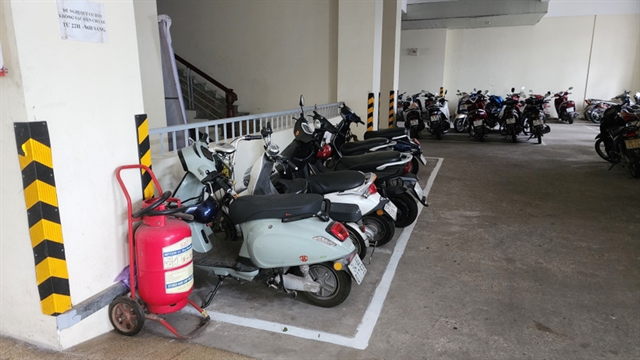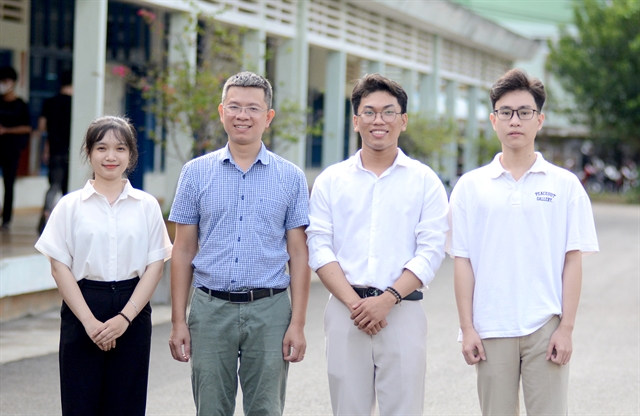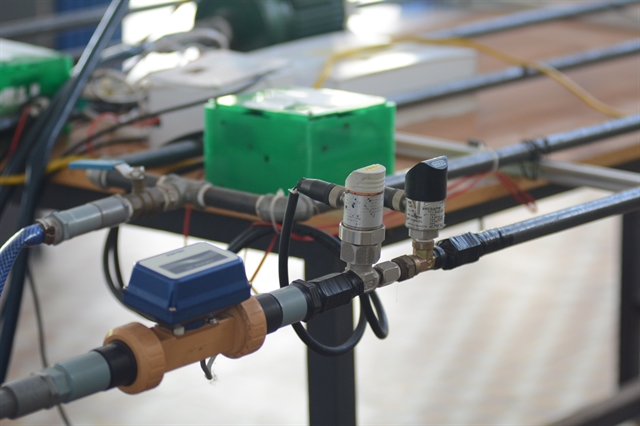 Society
Society

 |
| Dr. Phạm Thanh Phong (second from left) and students in the project researching a leak location monitoring device for liquid pipelines. — VNA/VNS Photos Văn Dũng |
ĐÀ NẴNG — The growing concern for environmental protection among young people, particularly students, is a noticeable trend.
A group of students at the University of Technology and Education - University of Đà Nẵng is working on an innovative project aimed at developing a device to detect and manage pipeline leaks.
This initiative, known as "Diagnosis and monitoring of leak points in liquid pipeline systems," is gradually taking shape and has the potential to significantly contribute to environmental protection.
The team of inventors behind this project includes Ngô Đăng Hùng, Trần Lê Đức An, Trần Thế Phong, Dương Thị Thanh Hà and Phạm Thanh Vỹ.
Dr. Phạm Thanh Phong, the head of the Automation Department, Faculty of Electrical and Electronics, who is guiding the project's development, said there are many devices designed to aid in detecting and pinpointing pipeline leaks.
However, he noted that many of these technologies are reliant on foreign sources.
These devices often require a substantial amount of time to locate the leak points, potentially resulting in economic losses and other adverse consequences if the leak is not promptly addressed.
Some of these devices need to be in direct contact with the pipeline's surface, which can present challenges when dealing with pipelines buried deep underground.
Given these considerations, the research team is actively working on the development of an intelligent device.
"This project was initiated in 2021 and has undergone various research stages. Currently, the system is in the process of refinement to enable the monitoring of water pipeline leaks," Phong told Vietnamplus.vn.
"Furthermore, this device holds the potential to extend its application to monitoring leaks in a wide range of liquid and gas pipeline systems."
Dr. Phong emphasised that once implemented, the equipment will offer a cost-effective alternative to imported machinery.
Speaking about the device's operation, Ngô Đăng Hùng, a fourth-year student and a member of the project team, said the system's primary purpose is to monitor leak locations, manage water shut-off, and measure water flow. All of these tasks are accomplished through a low-power, wireless communication network known as LoRa, a physical proprietary radio communication technique.
 |
| Leak location monitoring device. |
The system consists of both hardware and software.
The hardware comprises a system of iron water pipelines and a control unit on-site. Two types of sensors, for measuring flow and pressure, are installed at the beginning and end of the pipeline.
To read and transmit information from these sensors to the central control centre, the research team designed an intelligent control circuit. It uses a microcontroller with the capability to connect and transmit data through the low-power, wireless communication network LoRa.
In the monitoring control room, the team designed a central control unit responsible for receiving data from the on-site control units via the LoRa network. This central unit is connected to a monitoring computer.
The system's software includes a monitoring interface designed on WinCC and advanced algorithms to detect real-time leak locations.
Through this monitoring interface, operators in the control room can observe and access data related to water flow, control water shut-off and, notably, monitor leak locations in real-time if a leak occurs.
At the heart of this system is an advanced leak detection algorithm.
According to Dr. Phong, in the era of Industry 4.0, the digitalisation of management methods for water supply systems, wastewater treatment systems and fuel supply systems within factories is very important.
Monitoring, controlling and swiftly pinpointing the location of liquid leaks in pipeline systems plays a crucial role in promptly addressing issues, preventing losses, waste, environmental pollution, and even potential hazards to human safety.
Currently, in water treatment facilities in Việt Nam, detecting a leak location typically requires direct ultrasound equipment. This takes a lot of time and a lot of money.
Talking about their experiences and challenges in the project, Dương Thị Thanh Hà, a third-year student, said the project demanded advanced technology and high-performance microprocessors.
"The limited budget made it challenging to choose the right equipment and algorithms. I hope the design model can be applied directly into practice, helping to manage and monitor liquid leaks and contributing to environmental protection, particularly when dealing with waste or fuel leaks, and preventing their spread into the surrounding environment."
Phạm Thanh Vỹ, a research team member, expressed the hope that this research model will find widespread application in liquid monitoring activities. He also hopes for additional financial support to enhance and develop new, superior features to meet the actual needs of domestic and international companies. — VNS




